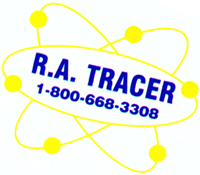


100% Canadian Owned
100% Canadian Owned |
|
|
HANDLING OF RADIOACTIVE FRAC SAND REGULATIONS The Canadian Nuclear Safety Commission regulations for disposal of sand labeled with a radioactive prescribed substance are as follows: “Contaminated sand to be buried at the worksite under at least 30 centimeters of soil provided that the specific activity is less than 370 kBq per kilogram of sand.” “Any other waste disposal method will require specific written approval to the Canadian Nuclear Safety Commission.” INTERPRETATIONThe above regulation refers to “370 kBq of activity” which is the equivalent of 10 microcuries (uCi) of Iridium 192, Scandium 46 and Antimony 124 per kilogram of frac sand. This amount translates into 10 millicuries per tonne of sand which is considerably higher than the amount injected per tonne (1 mCi/Tonne). CONTAMINATION MONITORING Returned sand can be assumed to be contaminated and buried as per instructions below under “Burial of Sand” R.A. Tracer will return to the location to monitor returned frac sand, prepare a contamination survey report and provide instructions on the steps that must be followed to safely satisfy regulation requirements. An additional fee will apply for this service. All monitoring performed by R,A, Tracer will be with the use of a Ludlum pancake monitor. The following calculations have been made for this specific instrument to correspond with necessary actions that need to be taken. The recorded level and action required are as follows:
BURIAL OF SAND
During clean-out:
Following clean-out: a. Rinse tools used in clean-out with water. b. Dispose of gloves used in clean-out. c. Wash hands in warm soapy water. UNDER NO CIRCUMSTANCES CAN THE CONTAMINATED SAND BE TAKEN TO A RECYCLING FACILITY. |